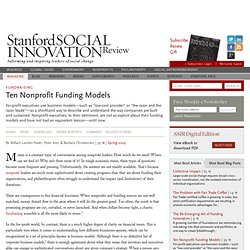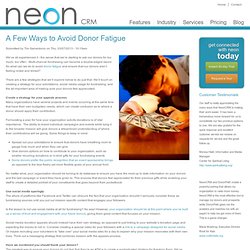

Ten Nonprofit Funding Models. For-profit executives use business models—such as "low-cost provider" or "the razor and the razor blade"—as a shorthand way to describe and understand the way companies are built and sustained.

Nonprofit executives, to their detriment, are not as explicit about their funding models and have not had an equivalent lexicon—until now. Money is a constant topic of conversation among nonprofit leaders: How much do we need? Where can we find it? Why isn’t there more of it? In tough economic times, these types of questions become more frequent and pressing. There are consequences to this financial fuzziness. In the for-profit world, by contrast, there is a much higher degree of clarity on financial issues. The value of such shorthand is that it allows business leaders to articulate quickly and clearly how they will succeed in the marketplace, and it allows investors to quiz executives more easily about how they intend to make money. Duke University business professor J. 5 Reasons Your Nonprofit Isn’t Raising Enough Money. 5 Reasons Your Nonprofit Isn’t Raising Enough Money By Nell Edgington The majority of nonprofits struggle to bring money in the door.

And they often don’t know why. When you are on the inside of an organization that is used to doing things a certain way it can be nearly impossible to see new opportunities, to understand what you could do differently. There can be many reasons why a nonprofit doesn’t bring enough money in the door. But here are the top 5 reasons a nonprofit struggles financially: Too Many Programs Drain Money From Your Organization.
If you’d like help to both assess why your nonprofit isn’t raising enough money and create a plan to raise more, join us for the Financing Not Fundraising E-Course. Photo Credit: tuppaware_001 Learn more about nonprofit innovation anddownload a free Financing Not Fundraising e-book when you sign up for email updatesfrom Social Velocity. How to Create a Nonprofit Financing (Not Fundraising) Plan. A Few Ways to Avoid Donor Fatigue. We’ve all experienced it - the sense that we’re starting to ask our donors for too much, too often.

Multi-channel fundraising can become a double-edged sword. So what can we do to avoid donor fatigue and ensure that our donors aren’t feeling nickel and dimed? There are a few strategies that we’ll explore below to do just that. We’ll touch on creating a strategy for your solicitations, social media usage for fundraising, and the all-important area of making sure your donors feel appreciated.
Create a strategy for your appeals process Many organizations have several projects and events occurring at the same time that have their own budgetary needs, which can create confusion as to where a donor should apply their contribution. Formulating a plan for how your organization solicits donations is of vital importance. Engaging Donors » Maytree. Financing Not Fundraising: 7 Mistakes in Your Nonprofit’s Fundraising Plan.
Financing Not Fundraising: 7 Mistakes in Your Nonprofit’s Fundraising Plan By Nell Edgington I can’t tell you how often I hear nonprofit leaders complain about how difficult it is to raise money, how tired they are of banging their head against the wall, how difficult this economy is. Well, there really is a better way. And it starts with a really good money plan for your organization. But again and again I see the same mistakes being made in nonprofit fundraising plans, which is the topic of today’s installment of our regular Financing Not Fundraising blog series. If you’re new to the series, our Financing Not Fundraising blog series shows nonprofits how to break out of the narrow view that traditional FUNDRAISING (individual donor appeals, events, foundation grants) will completely fund all of their activities and instead work to create a broader approach to securing the overall FINANCING necessary to create social change.
Half of Fundraisers in the Top Job Would Like to Quit - News. By Jennifer C.

Berkshire One in four nonprofit leaders is so disappointed in fundraising at his or her organization that the last person in the job was fired, according to a new national study to be released this week. And milder frustration is rampant: One in three executives is at best lukewarm about the person now holding the top development job. But chief fundraisers have their own complaints about CEO’s, boards, and the support their organizations have given them. As a result, many of them are looking to leave their jobs—or possibly leave fundraising altogether, the survey found.
The study, one of the biggest national surveys of its kind, gathered data from more than 2,700 development directors and charity heads who work at organizations of different sizes and missions. . • Half of the chief fundraisers plan to leave their jobs within two years or less. . • More than half of the executive directors reported that they can’t find well-qualified people to run their fundraising staffs.
Ms.